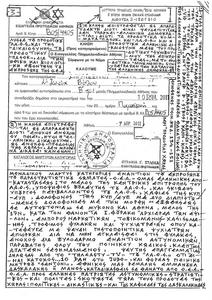Δικομματισμός φίλε μου, ασπρο-μαύρο. "καραμανλης ή τανγκς"
ΠΑΣΟΚ ή ΝΔ (με τα παρελκόμενα κομματακια ΣΥΡΙΖΑ-ΛΑΟΣ-ΔΑ-Ντοριτος)
History
Tang was famously used by some early NASA manned space flights. In 1962, when Mercury astronaut John Glenn conducted eating experiments in orbit, Tang was selected for the menu,[2] and was also used during some Gemini flights. A NASA engineer working on Gemini explained how and why it was used (paraphrased):
"There was a particular component of the Gemini life support-system module which produced H2O (water) among other things. This was a byproduct of a recurring chemical reaction of one of the mechanical devices on the life-support module. The astronauts would use this water to drink during their space flight. The problem was, the astronauts did not like the taste of the water because of some of the byproducts produced, which were not harmful of course. So, they added Tang to make the water taste better."[6]
The creator of Tang, William A. Mitchell, also invented Pop Rocks, Cool Whip, a form of instant-set Jell-O, and other convenience foods.[7]
[edit]Original Tang
Tang is sold both in powdered and ready to drink form. The recommended usage of original powdered Tang is two tablespoons per 8 US fluid ounces (240 ml; 8.3 imp fl oz) of water. A single 8 US fl oz (240 ml; 8.3 imp fl oz) serving of Tang provides 9 grams (0.32 oz) of sugar; 40 calories (167 kJ); 100% RDA of vitamin C; 10% RDA of vitamin A, calcium, vitamin E, riboflavin, niacin, and vitamin B6, and no caffeine.
Kraft also makes a sugar-free version of Tang, containing aspartame, which comes in individually-measured packets and was introduced in March 1985.
[edit]Other versions
In 2007, Kraft introduced a new version of Tang which replaced half of the sugar with artificial sweeteners. The new packaging advertises "1/2 the Sugar of 100% juice".[8] The artificial sweeteners used in the new formulation are Sucralose, acesulfame potassium, and Neotame. The new formula is more concentrated and distributed in smaller containers, with a 12.3 US fl oz (360 ml; 12.8 imp fl oz) (348 g (12.3 oz)) container making 8 US quarts (7,600 ml; 270 imp fl oz).
The recommended usage is two and one-half teaspoons per 8 US fluid ounces (240 ml; 8.3 imp fl oz) of water. The lid on the new smaller plastic container acts as a measuring cup which may be used to make one or two quart quantities, the same as the original Tang.
As of December 2009, the 12.3 US fl oz (360 ml; 12.8 imp fl oz) lower calorie Tang has been discontinued and is no longer available from Kraft.
In 2009, another version of Tang emerged in 20 US fl oz (590 ml; 21 imp fl oz) containers making only 6 US quarts (5,700 ml; 200 imp fl oz). Two level tablespoons make one serving (8 US fl oz (240 ml; 8.3 imp fl oz), 90 calories) with 0 g fat, 35 mg (0.54 gr), 22 g (0.78 oz) total carbohydrate (sugar), and 0 g protein. Its list of ingredients include sugar, citric acid (provides tartness), contains less than 2% of natural and artificial flavor, ascorbic acid (vitamin C), maltodextrin, calcium phosphate (prevents caking), guar and xanthan gums (provides body), sodium acid pyrophosphate, artificial color, yellow 5, yellow 6, BHA (to help protect flavor).




 ) του πράσινου αγώνα
) του πράσινου αγώνα







